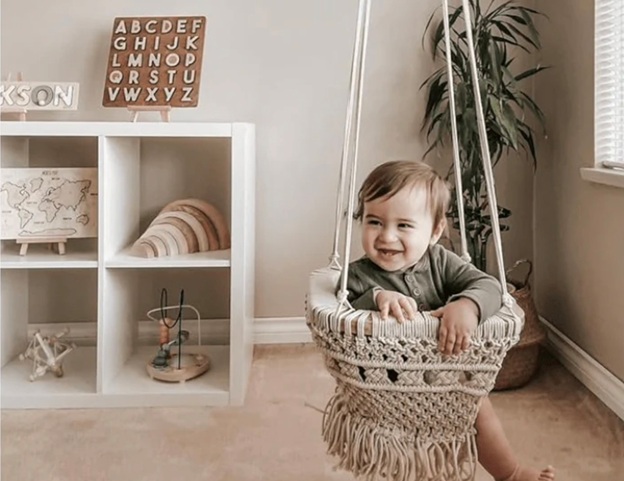As you prepare to welcome your little one into the world, creating a safe, nurturing space is at the top of your list. But what if your nursery could do more than just look beautiful? By designing an eco-friendly nursery, you’re not only protecting your baby’s health—you’re also making choices that benefit the planet. From organic baby clothes to non-toxic paint, sustainability starts at home, and it begins in your baby’s room.

In this guide, we’ll walk you through how to create an eco-conscious nursery with practical tips, sustainable swaps, and eco-friendly must-haves.
Why Choose an Eco-Friendly Nursery?
A newborn’s developing body is more sensitive to chemicals and toxins commonly found in household items. Traditional baby products, furniture, and even clothing can contain VOCs (volatile organic compounds), synthetic dyes, pesticides, and flame retardants that may irritate your baby’s skin or impact indoor air quality.
An eco-friendly nursery minimizes these risks by using natural, organic, and sustainable materials. This not only reduces exposure to harmful substances but also contributes to a greener planet by lowering your carbon footprint.
Key Elements of an Eco-Friendly Nursery
-
Non-Toxic Paint and Finishes
Start with the walls—choose paints labeled “zero-VOC” or “low-VOC” to improve indoor air quality. These paints release fewer harmful fumes and are safer for both baby and parents.
For furniture, opt for items finished with water-based stains or natural oils. Avoid pressed wood or particleboard, which can emit formaldehyde.
-
Sustainable Furniture Choices
When it comes to cribs, dressers, and rocking chairs, look for brands that use solid wood sourced from sustainably managed forests (FSC-certified is a good standard). Many companies now offer cribs that grow with your child, extending the life of the furniture and reducing waste.
Consider secondhand furniture as well. Vintage pieces can be charming and eco-friendly—but always check for safety recalls and make sure they meet current safety standards.
-
Natural Flooring and Rugs
Hardwood, bamboo, or cork flooring is ideal for a green nursery. If you want a softer touch, choose area rugs made from organic cotton, jute, or wool. Avoid synthetic rugs that may contain flame retardants and petroleum-based fibers.

Choosing Organic Baby Clothes
Organic baby clothes are one of the easiest and most impactful swaps you can make in your nursery. Your baby’s skin is incredibly delicate, and it’s in constant contact with clothing, bedding, and blankets. That’s why choosing natural, chemical-free fibers is so important.
At Finn + Emma, our organic baby clothes are made from GOTS-certified (Global Organic Textile Standard) organic cotton—free from pesticides, herbicides, and harsh dyes. They’re gentle on baby’s skin and the planet.
Here’s why organic baby clothes matter:
- No Harsh Chemicals: Conventional cotton is one of the most pesticide-heavy crops. Organic cotton is grown without toxic substances that can linger in fibers and irritate sensitive skin.
- Breathable and Hypoallergenic: Organic cotton allows better airflow and is naturally hypoallergenic, making it ideal for babies prone to rashes or eczema.
- Eco-Conscious Production: Our clothing is ethically produced in fair-trade settings, supporting both environmental sustainability and workers’ rights.
Whether it’s a onesie, footie, romper, or organic cotton baby pajamas, choosing organic means you’re giving your child the softest, safest start.
Bedding and Mattresses: Sleep Green
Your baby will spend up to 16 hours a day sleeping—so what they sleep on matters. Here’s how to make your baby’s sleep environment eco-friendly:
- Choose an Organic Crib Mattress: Look for mattresses made with certified organic cotton, wool, or natural latex. Avoid foam mattresses made with polyurethane, which can off-gas harmful chemicals.
- Use Organic Bedding: Sheets, blankets, and mattress covers should be made with 100% organic cotton or bamboo. These materials are breathable, gentle, and free from harmful dyes or bleach.
- Minimal Layers: Babies don’t need a mountain of bedding. A simple fitted sheet and sleep sack or wearable blanket made from organic cotton is both safe and sustainable.

Eco-Friendly Decor and Toys
Decorating a nursery is one of the most exciting parts of preparing for your baby—but it doesn’t have to be wasteful.
- Natural Mobiles & Wall Art: Choose decorations made from wood, organic felt, or recycled materials. Handmade and artisanal items often have a smaller carbon footprint than mass-produced decor.
- Non-Toxic Toys: Wooden toys, organic cotton stuffed animals, and fabric books are great alternatives to plastic toys. At Finn + Emma, our macrame swings, play gyms, and eco-friendly toys are made from natural materials that are safe for teething and play.

Smart Energy & Air Quality Choices
- Use LED Bulbs: Energy-efficient LED lighting reduces electricity usage and stays cool to the touch—safer for curious hands.
- Control Air Quality: Open windows daily to let in fresh air, and consider a HEPA air purifier if your home has high pollution or allergens.
- Go Digital with Thermostats: Smart thermostats help keep the nursery at an ideal temperature (between 68–72°F) without wasting energy.
Green Diapering & Waste Reduction
Diapering is one of the most waste-heavy parts of caring for a baby—but small swaps can go a long way.
- Cloth Diapers: Reusable cloth diapers cut down on landfill waste and save money in the long run. Look for organic cotton or bamboo inserts.
- Eco-Friendly Disposables: If cloth isn’t for you, there are now many plant-based, biodegradable diaper options that perform well without the plastic.
- Reusable Wipes & Baskets: Swap disposable wipes for cloth ones, and organize your nursery with storage bins made from recycled or sustainable materials.
Final Tips: Sustainability in Practice
- Start Small: You don’t have to overhaul everything at once. Even choosing one or two eco-friendly items can make a difference.
- Quality Over Quantity: Choose fewer, better-made items that last longer and hold up through multiple children or resale.
- Buy Local and Ethical: Supporting brands that are transparent about their production processes, like Finn + Emma, keeps your nursery both ethical and beautiful.
Takeaways: Building a Better Nursery
Designing an eco-friendly nursery is more than a design trend—it’s a commitment to your baby’s well-being and the planet’s future. By choosing organic baby clothes, non-toxic furnishings, and sustainable decor, you create a space that’s both healthy and stylish.
✅ Look for GOTS-certified organic cotton for clothing and bedding.
✅ Use low-VOC paints and solid wood furniture.
✅ Prioritize natural materials for toys, rugs, and mattresses.
✅ Embrace minimalism and quality over quantity.
Whether you’re just starting your nursery journey or ready to make a few eco-friendly upgrades, Finn + Emma is here to help you every step of the way—with stylish, sustainable, and safe essentials for modern parents.
